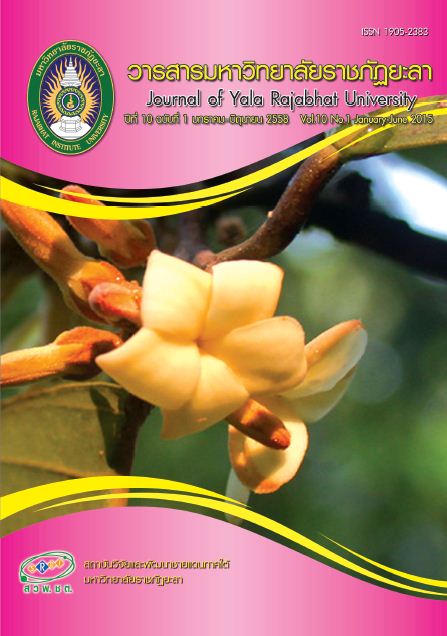การวัดค่าความเข้มข้นนํ้ายางพาราด้วยเทคนิคตัวเก็บประจุทรงกระบอก
Main Article Content
บทคัดย่อ
ราคาการจำหน่ายนํ้ายางพาราขึ้นกับร้อยละเนื้อยางแห้งเป็นสำคัญ การวิจัยนี้จึงนำเสนอแนวทางใหม่สำหรับการออกแบบและวัดค่าความเข้มข้นของนํ้ายางพาราโดยวิธีตัวเก็บประจุทรงกระบอกในรูปของความต่างศักย์ไฟฟ้า ซึ่งมีแรงดันไฟฟ้าป้อนเข้าในช่วง 5.8 - 17.0 โวลต์ ร้อยละของนํ้าที่ผสมในนํ้ายางพาราเท่ากับ 10 20 30 40 50 60 70 80 และ 90 โดยปริมาตร ตามลำดับ แล้ววิเคราะห์ความสัมพันธ์เมื่อมีการเปลี่ยนแปลงความต่างศักย์ไฟฟ้าในนํ้ายางพารากับร้อยละเนื้อยางแห้ง จากการทดลองพบว่า เมื่อร้อยละของนํ้าที่ผสมในนํ้ายางพาราเพิ่มขึ้น ร้อยละเนื้อยางแห้งมีค่าลดลง เมื่อวิเคราะห์ความสัมพันธ์ระหว่างร้อยละเนื้อยางแห้งกับความต่างศักย์ไฟฟ้า พบว่า มีความสัมพันธ์ในลักษณะเอกซ์โปเนนเชียล ซึ่งมีค่าสัมประสิทธิ์สหสัมพันธ์ (R2) อยู่ในช่วง 0.918 - 0.954
Article Details
บทความ ข้อมูล เนื้อหา รูปภาพ ฯลฯ ที่ได้รับการเผยแพร่ในวารสารมหาวิทยาลัยราชภัฏยะลานี้ ถือเป็นลิขสิทธิ์ของวารสารมหาวิทยาลัยราชภัฏยะลา หากบุคคลหรือหน่วยงานใดต้องการนำทั้งหมดหรือส่วนหนึ่งส่วนใดไปเผยแพร่ต่อหรือกระทำการใดๆ จะต้องได้รับอนุญาตเป็นลายลักษณ์อักษรจากวารสารมหาวิทยาลัยราชภัฏยะลาก่อนเท่านั้น
เอกสารอ้างอิง
2.ประยุทธ อัครเอกฒาลิน, เสวก พงษ์สำราญ และสมพร ศรีวัฒนพล. (2556). เครื่องวัด %DRC โดยใช้ความถี่คลื่นไมโครเวฟ. [ออนไลน์]. ค้นเมื่อ 15 กุมภาพันธ์ 2556, จาก : http://www.cop.rmutsb. ac.th/userfiles/3229900157632/DRC_somporn.pdf.
3.ปรีดาวรรณ ไชยศรีชลธาร, ชูศักดิ์ ชวประดิษฐ, สุภัทร หนูสวัสดิ์ และสันติ โพธิทอง. (2554). การศึกษาหาปริมาณเนื้อยางแห้งในนํ้ายางพาราด้วยวิธี Platform Scale Method. ว. วิทย. กษ., 42(3)(พิเศษ), 753-756.
4.วิสุทธิ์ ศุกลรัตน์. (2546). การสร้างละพัฒนาเครื่องต้นแบบวัดปริมาณเนื้อยางแห้งชนิดพลาสติก.สงขลา : ศูนย์วิจัยยางสงขลา สำนักวิจัยและพัฒนาการเกษตร เขตที่ 8 กรมวิชาการเกษตร.
5.วุฒิไกร จำรัสแนว, ปานหทัย บัวศรี และกิตติพงษ์ ตันมิตร. (2551). ศึกษาคุณสมบัติไดอิเล็กตริกเพื่อใช้ในการวัดระดับความเข้มข้นของนํ้ายางพารา. การประชุมวิชาการเทคโนโลยีและนวัตกรรมสำหรับการพัฒนาอย่างยั่งยืน, 28-29 มกราคม 2551. ขอนแก่น : คณะวิศวกรรมศาสตร์ มหาวิทยาลัยขอนแก่น.
6.สำนักงานกองทุนสงเคราะห์การทำสวนยาง กระทรวงเกษตรและสหกรณ์. (2557). สถิติยางไทย. [ออนไลน์]. ค้นเมื่อ 18 ตุลาคม 2557, จาก : http://www.rubberthai.com/
statistic/stat_index. htm.
7.Bewick, V., Cheek, L. and Ball, J. (2003). Correlation and regression. Critical Care, 7, 451-459.
8.Brown, J. D. (2003). The coefficient of determination. Shiken: JALT Testing & Evaluation SIG Newsletter, 7(1), 14-16.
9.Chaisrichonlathan, P., Chavapradit, C., Noosawasd, S. and Pothong, S. (2011). Study on dry rubber content in latex using platform scale method. Agricultural Sci. J., 42(2) (Suppl.), 753-756.
10.Cornell, J. A. and Berger, R. D. (1987). Factors that Influence the value of the coefficient of determination in simple linear and nonlinear regression models. The American Phytopathological Socity, 77(1), 63-70.
11.Harris, E. M., Nor Aisah bt. Abd. A. and Morni bt. A. (1985). Measurement of dry rubber content of natural rubber latex and wet crepe using specific heat. Proceedings of the International Rubber Conference. Xx-xx Mar 1985. Kuala Lumpur: Rubber Research Institute of Malaysia.
12.Jatuporn, S. (2006). Rheological properties of natural rubber latex. Master’s thesis. Suranaree University of Technology, Institute of Engineering, Polymer Engineering, Thailand.
13.Jayanthy, T. and Sankaranarayanan, P. E. (2005). Measurement of dry rubber content in latex using microwave technique. Measurement Science Review, 5(3), 50-54.
14.Kaida, B. K. (1982). Determination of dry rubber content of hevea latex by microwave techniquel. Pertanika, 5(2), 192-195.
15.Liao, J. G. and McGee, D. (2003). Adjusted coefficients of determination for logistic regression. The American Statistician, 57(3), 161-165.
16.Mahmoud, S. and Reza, A. (2011). Moisture dependent dielectric properties of pea and black-eyed pea. Journal of American Science, 7(4), 60-64.
17.Malgady, R. G. and Krebs, D. E. (1986). Understanding correlation coefficients and regression. PHYS THER., 66(1), 110-120.
18.Nagelkerke, N. J. D. (1991). A note on a general definition of the coefficient of determination. Biometrika, 78(3), 691-692.
19.Panu, D., Paitoon, L. and Rachatham, W. (2012). Correlation between dry rubber content in field latex and viscosity measured with efflux time method. Songklanakarin J. Sci. Technol., 34(5), 551-555.
20.Taylor, R. (1990). Interpretation of the correlation coefficient: A basic Review. JDMS., 1, 35-39.
21.Young, H. D. and Freedman, R. A. (2013). University Physics with Modern Physics. 13th ed. California: Pearson Education Inc.


